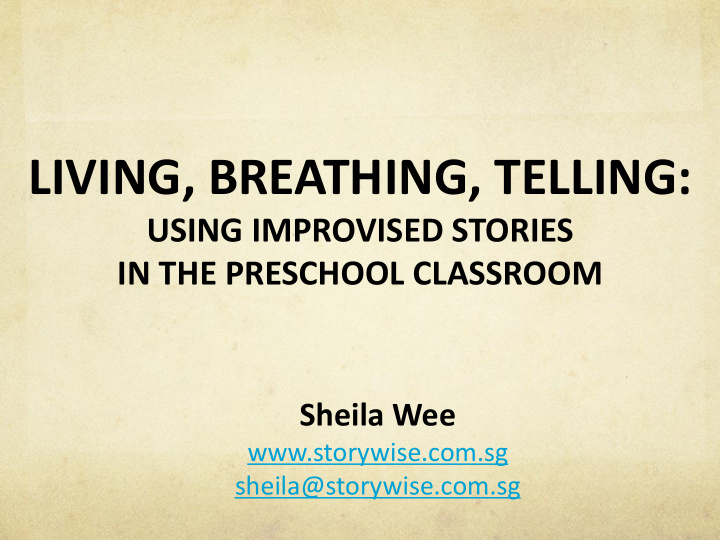



LIVING, BREATHING, TELLING: USING IMPROVISED STORIES IN THE PRESCHOOL CLASSROOM Sheila Wee www.storywise.com.sg sheila@storywise.com.sg
WATCH THIS…. http://tinyurl.com/n7r7bwv
Find a partner and describe what you just saw. This was an experiment carried out by behavioural psychologists in 1944. In the experiment 114 of 117 study participants described a story. "F. Heider and M. Simmel. An experimental study of apparent behaviour". American Journal of Psychology, 13, 1944.
FIND A PARTNER Tell your partner about: How you got that scar • Or The best, or worst, present you have ever been given • Or A time that you were naughty as a child
If we are feeling comfortable, our own stories flow out from us naturally and easily. http://weeknights.deviantart.com/art/A-Flow-of-Words-70447411
We all have minds stuffed full of: memories facts emotions sensory impressions Photo: MattRobinson - https://www.flickr.com/photos/fumauk/3784567423/in/photostream/
If we have a relaxed and playful attitude, our unconscious mind can supply us with a stream of material for improvising stories.
THE INTERRUPTER
THE BENEFITS OF CHILDREN LISTENING TO AND TELLING STORIES
GIVE ME A WORD
THE CHARACTER FIRST METHOD A Method For Creating Stories My thanks go to Kendall Haven for teaching me this method. www.kendallhaven.com
STEP 1 DECIDE ON A CHARACTER It can be a human, an animal, or an object It must be a completely new character
STEP 2 DEVELOP THAT CHARACTER Name Age Something about what he/she /it looks like Something about his/her/its personality
STEP 3 DECIDE ON THE CHARACTER’S GOAL What does the character want to do, or want to have? It can be anything
STEP 4 DECIDE ON THE OBSTACLE Why hasn’t the character got what he wanted?
STEP 5 DECIDE HOW THE STORY IS GOING TO END There are two possible endings He doesn’t get He gets what what he he wants wants
PAPER TEARING STORIES
Record CREATE and/or Recall Read and/or Write Illustrate LINKING IMPROVISED Retell STORIES TO LITERACY
Recommend
More recommend